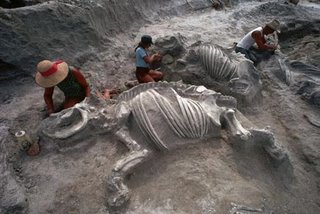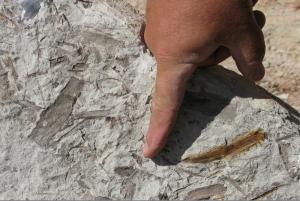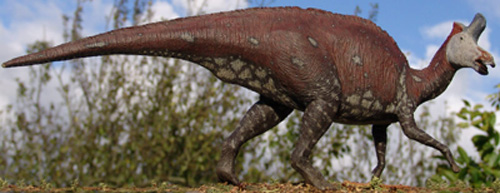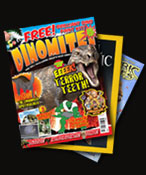Rareresource
Sunday, December 28, 2008
Humans lived alongside dinosaurs
Tuesday, December 23, 2008
Dinosaurs Were Airheads CT Scans
A new study by Ohio University researchers Lawrence Witmer and Ryan Ridgely found that dinosaurs had more air cavities in their heads than expected. By using CT scans, the scientists were able to develop 3-D images of the dinosaur skulls that show a clearer picture of the physiology of the airways.
“I’ve been looking at sinuses for a long time, and indeed people would kid me about studying nothing—looking at the empty spaces in the skull. But what’s emerged is that these air spaces have certain properties and functions,†said Witmer, Chang Professor of Paleontology in Ohio University’s College of Osteopathic Medicine.
Monday, December 22, 2008
Fossil "Pompeii" of Prehistoric

In 1971 he found a skull of a rhino calf protruding from an eroding ravine. The skull turned out to be part of a complete skeleton embedded in volcanic ash.
Voorhies led excavations of the site in 1978 and 1979, supported by a grant from the National Geographic Society's Committee for Research and Exploration. (National Geographic News is part of the National Geographic Society.)
About 12 million years ago, a volcano in modern-day Idaho spread a blanket of ash over large parts of what is now the midwestern United States. A layer of this powdered glass one or two feet (one- to two-thirds of a meter) thick covered the grasslands of northeastern Nebraska.
Most of the animals living in the area survived the actual ashfall, but as they continued to graze on the ash-covered grasses, their lungs began to fill with the deadly particles.
Tuesday, December 16, 2008
Winton Dinosaurs
The dinosaur bones are from rocks found in the Winton Formation, a geological layer 102-98 million years old. Since excavations began, several other types of dinosaurs have been found, including plant-eating ankylosaurs and ornithopods, plus the serrated teeth of carnivorous theropod dinosaurs.
Among the remains of these dinosaurs are the fossils of small animals and plants, which may have been considered dinosaurs' food!
Volunteers from across Australia and overseas help to excavate the dinosaur bones, putting them in plaster jackets ready for transport to the lab. There, they are painstakingly prepared for scientific study and display.
Friday, December 12, 2008
Utah Shows Land Plants Of 200 Million Years Ago

new archeological site in St George, Utah, U.S. was recently highlighted by Andrew Milner, Paleontologist, City of St. George, Jim Kirkland, State Paleontologist and Sidney Ash, Paleo-botanists. The site is significant because it is the only early Jurassic land flora known in the western United States. It provides evidence that a variety of land plants were present in the area about 200 million years ago.



